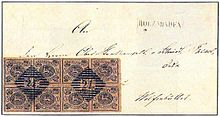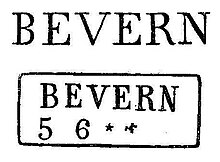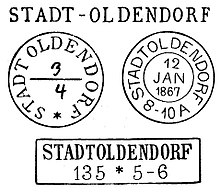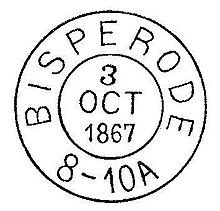Post route Braunschweig – Holzminden
This article deals with the traveling and mounted guards to Göttingen and on to Kassel. The article also deals with the postal history of the places in the Holzminden district.
Riding and driving mail
The post-chart from 1714 shows the possibility of a connection from Braunschweig via Wolfenbüttel to Kniestedt , via Grasdorf to Hildesheim and via Alfeld and Eschershausen to Holzminden .
A Braunschweigische Landespost already existed in Holzminden before 1743, because even before the mail from Braunschweig to Holzminden in 1743, there was a route of the riding postman from Braunschweig via Gandersheim, Holzminden to Paderborn.
For the year 1764, the Imperial Post Office operated by Thurn und Taxis gives the driving posts from Braunschweig via Wolfenbüttel 1 - Barum 2 - Lutter 2 - Seesen 2 - Gandersheim 1 - Greene 1 - Wickensen 2 to Holzminden 1 and further via Höxter 2 - Carlshaven 2 to Kassel 3 miles. As well as the second route from Braunschweig and Wolfenbüttel 1 - grid 4 - Greene 4 - Hamelsborn 3 to Holzminden 2 and on via Brackel 3 to - Paderborn 3 miles.
180 years after the establishment of a riding post from Berlin to the Prussian Rhine provinces, the need to shorten the route was recognized, not around the Duchy of Braunschweig, but from Helmstedt to Holzminden through the Duchy. The two postal authorities agreed in 1822 on a riding post from Berlin via Magdeburg, Braunschweig, Seesen, Holzminden, Paderborn to Düsseldorf and Cologne.
In Braunschweig there were already two express posts in 1832, in the summer half-year twice a week via Königslutter and Helmstedt with a connection to Berlin, in summer with the express car or diligence, or in winter with the usual, moving mail. Also twice a week express mail from Braunschweig via Wolfenbüttel, Halberstadt and Halle to Leipzig and next to it a moving post to Leipzig.
There were also riding posts :
- 1. Four times a week to Northeim, and from there to Göttingen, Kassel, Frankfurt etc.
- 2. Four times a week to Celle, Bremen Oldenburg, East Friesland, Hamburg, Scandinavia etc.
- 3. Twice to Holzminden, Paderborn (the Prussian Berlin – Cölner), to Hanover and Hildesheim.
There were traveling posts to Calvörde, Kassel, Celle (Bremen) Hanover, Hildesheim, Goslar (and the Harze), Halberstadt (Saxony and Austria), Hamburg (Denmark and the north), Hameln, Holzminden (Prussian to Paderborn, Westphalia and Hesse ) Northausen (formerly the yellow coach) and once a day to Wolfenbüttel.
Holzminden
The Braunschweigische Landespost existed in Holzminden before 1743; because even before the mail from Braunschweig to Holzminden in 1743 there was a route of the riding postman from Braunschweig via Gandersheim, Holzminden on to Paderborn.
During the Napoleonic period (1808–1813) the first one-liner "HOLZMINDEN" was used between 1809 and 1834. As the post director of the Royal Westphalian Post, Mr. Raabe is named as Directeur 3rd class (1810–1813).
Another one-liner was used between 1831 and 1835.
From 1835 on, only the buckle stamp with the printing number, which was used exclusively in Holzminden, was used for letter stamps. After 1853 he can also be found on receipts from the post office's office staff.
Since 1853 a rectangular stamp with the date, star and time in digits has been cut off. The two-circle stamp with day, month, year and time came to Holzminden in 1866. The rust-diamond stamp with the number "24" was used to cancel the postage stamps
A smaller two-circle stamp with date and morning / evening was used as the arrival stamp .
The Post General Circular reported that the change of chart between Holzminden and the Thurn & Taxis post office in Bremen has been canceled. The new convention with Thurn & Taxis came into effect on November 1st, 1835. "The change of charts between Holzminden and Lemgo, also Detmold (postage 2 Ggr. For ¾ Loth) was retained" .
The following postmasters at the post office in Holzminden are listed in the address books: August Heinrich Raabe, Postrath (1833–1840), Carl Raabe (1841–1854) “Postal Secretary Raabe zu Holzminden is the postmaster on January 15, 1846, the previous postal clerks Feise and Rosenbaum has been appointed postal secretary ”, Georg Lindau (1854–1865),“ His Highness the Duke graciously deigned to give the postmaster Lindau zu Holzminden the character 'Postrath' ”(from 1864), Albert Damköhler (14 August 1865–1871) , between 1843 and 1845 he was transferred from Braunschweig to Holzminden and back to Braunschweig as a mail clerk. Before he came to Holzminden, he was in Harzburg. The Brunswick advertisements reported on October 5, 1865: "The postmaster Damköhler was entrusted with the management of the railway and post office in Holzminden". Theodor Hörstel (1872–1876), Werner Persun (1877–1879), Otto Wirstorf (1880–1893) followed as post directors; During his time in 1887 it was converted into a first class post office. Other postal directors in Holzminden were Carl Knackstedt (1894–1896), Martin Kesting (1897–1903) and Oskar Georgii (1904–1916).
In 1844 the simple decoration went to the postilion Ludwig Kühne zu Holzminden.
The Braunschweig advertisements served as the next source. She reported on August 10, 1865: “In Holzminden a) Courant up to 8 lots and b) paper money and other valuables up to 50 thalers and weighing up to 8 lots are delivered. The delivery is certified in the receipt book. "
The famous postman Rudolf Schottelius (born July 26, 1816 in Braunschweig, † March 31, 1881 in Braunschweig) attended high school in Holzminden; then he took up his first job in 1834 as a post clerk in Wolfenbüttel. In 1848 he became postal inspector and in 1868 after the establishment of the North German Federal Chief Postal Director and head of the Braunschweig postal inspection. It is to his initiative that Braunschweig became the seat of an imperial post office.
Fürstenberg on the Weser
In 1747, Duke Carl I ordered the installation of the Fürstenberg porcelain factory , which probably led to the establishment of a post expedition.
During the Napoleonic occupation, the post office was under the control of the post transporter Lungershausen (1810-1813). It was given a one-liner stamp that remained in use until 1830. Followed by another one-liner that was used until 1854. Since 1840 the date has occasionally been handwritten.
A convention of November 1, 1835 with the Thurn und Taxisische Post concerned the post route Holzminden-Kassel via Lauenförde and Carlshafen.
The rectangular stamp with date, star and time was introduced in 1853. The obligatory rust-diamond stamp with the number "13" was delivered to cancel the postage stamps .
In 1878, which was post-expedition in a post office converted.
Bevern
It can be assumed that Bevern had his post office since 1743, with the establishment of the driving post from Braunschweig to Holzminden. Letters from this period have a handwritten place note. It will have been a collection of letters.
The collection of letters also existed in the time of the Kingdom of Westphalia . Although Bevern is not mentioned in the relevant literature on postal services in the Kingdom of Westphalia. However, the one-liner is known from this period . After the expulsion of the French, it continued with the same stamp. Since 1836 the date has been handwritten in numerals.
In the address books, since 1833, a post office is given under the postman Friedrich Mönkemeyer (1833-1851) for Bevern.
In the General Circular (90) of April 20, 1850 it is reported that the postman Mönkemeyer (1833–1850) died in Bevern, his successor was foreman August Uhden (1852–1873) as a postal expedition.
In 1852 the post in Bevern was given the rank of postal expedition . Bevern received a two-line rectangular stamp . Since 1856 the postage stamps have also been canceled with the rust-diamond cancel with the number "3". The Reichspost made the postal expedition into a postal expedition 2nd class in 1870 and converted it into a postal agency in 1874. Post agent was August Uhden, as before in 1879; maybe it was the son by now. He was followed by Hugo Uhden and Albert Stuckenberg until 1892. Some surrounding villages were supplied by country mail carriers.
Ottenstein
Since when a post office in Ottenstein (place with district court) existed, it could not be determined. In the Kingdom of Westphalia , Ottenstein in the Fulda department belonged to the Höxter district in the canton of Bodenwerder. From September 1, 1810, with the incorporation of Hanover, it came into the department of the Leine and belonged to the canton of Rinteln. There was a mail expedition here under the post of Wilke (1810–1812). No stamps from this period are known.
In addition to letters with a place mark, there were also cursive stamps with and without a margin. The date was handwritten between 1834 and 1843. In 1845 there was the two-circle chord stamp in which the date should also be inserted by hand. In 1859 the two-circle stamp came with the date, year and time. The stamps were canceled with the rust-diamond cancel with the number "34".
In the address books (from 1833) postal expedients are listed until 1871. In 1872 the post office was transformed into a post office and in 1897 into a post office administration under the post of mail expedition and then post agent Ludwig Beißenhirtz (1871-1893). Post administrator was August Meiburg (1897-1916).
In Circular 82 of October 13, 1862, the country courier service in the districts of the post offices in Ottenstein and Hehlen was regulated.
Hehlen (Bodenwerder)
A post expedition received Hehlen November 1, 1862, Postexpedient was the merchant Ludwig Zeidler (1862-1870) and Henry Boker, (1871).
Converted into a postal agency in 1872 , the postal agents were Heinrich Böker (1872–1889), Werner Böker (1890–1892), Carl Sagebiel (1893–1896) and Wilhelm Sagebiel (1897–1916). They used the two-circle stamp with the date, year and time. The rust-diamond stamp with the number "26" which had previously been used in Immendorf was used to cancel the postage stamps .
Stadtoldendorf
The post office from Braunschweig to Holzminden, set up in 1743, also drove through Stadtoldendorf , at which time there was probably a post office attendant. Letters with handwritten location information are known.
During the Westphalian period, Stadtoldendorf belonged to the Leine department , the Einbeck district and the canton Stadtoldendorf. In the city there was a postal expedition led by the expedition Meyer (1810-1813). He used the one-liner city - Oldendorf. A stamp "FRANCO" has also become known.
His successors used the one-liner until 1852, adding the date by hand. In addition, from 1839, a single-circle stamp with a date line in the middle was used, where the date had to be entered by hand. From May 1851, blue stamp ink was used.
Since 1849, Negenborn and Golmbach have been supplied with mail from Stadtoldendorf, as reported by the General Circular.
In 1856 a rectangular stamp was put into use.
The Braunschweig announcements of October 5, 1865 report the renaming of the postal expedition to the Stadtoldendorf railway and post office under the post of Fritsche. In the same year the two-circle stamp with date, year and hours as well as a two-line “Delivered / Date” and a rectangular stamp “From the mailbox” came into use. In the Braunschweig advertisements of March 24, 1866, it says: “In accordance with a recript of the ducal state ministry dated 2. d. On the month of the month, the administration of the Stadtoldendorf railway and post office was temporarily transferred to Lüddecke, a postal assistant. ” A few months later, on July 25, the post was transferred to the station by law. At the beginning of 1867, the personal mail between Eschershausen and Vorwohle - train station - was canceled and a local personal mail between Eschershausen and Stadtoldendorf was set up in its place.
Since 1850 Hermann Bock (1850–1874) has been named in the address books as a postman. He was responsible for the horses. The wagon master Carl Stümpel (1866–1874) supported him from 1866 onwards.
Amelungsborn Monastery
There was a post office in the Amelunxborn monastery in 1825, and Bernhard Kuhlmann is named as the postman. When he died, the post office was closed on October 1, 1842 (Circular 44).
From October 1, 1847, there was a mail collection point for local correspondence. The mail was supplied by exchanging the mail bags with the mail coach passing through between Eschershausen and Stadtoldendorf. Between 1846 and 1849 there was a post office again.
The required location on the letters was handwritten between 1830 and 1834 with “Amelungsborn” (with g). From March 1843 a two-line stamp “Amelunxborn / Date (day in digits, month in letters”) replaced the handwritten note on the letters. Whether it is a postmark can be doubted. It is also found on receipts for road allowances. From 1835 to 1840 again handwritten on the letters "Amelungsborn". A single-circle stamp "Amelunxsborn" with a date line is known from 1840 to 42. The date has probably never been filled in, the markdown is mostly unclean. From 1843 the place mark "Amelunxborn" (with x), some of the items also received the postmark from Eschershausen.
Eschershausen
see postal history of Eschershausen
Wickensen
The Imperial Post Office operated by Thurn and Taxis already had a mail service from Braunschweig via Gandersheim 1 - Greene 1 - Wickensen to Holzminden in 1764. Around this time a post office was probably set up in Wickensen.
In the time of the Kingdom of Westphalia , Wickensen was part of the Leine department in the Rinteln district. In the Almanac Royal one is post expedition called; The shipping agent was Mittendorf (1810–1813); he used the one-liner stamp. After the Wars of Liberation, the postal expedition was canceled on August 5, 1817. The postal service was taken over by Eschershausen.
Halle on the Weser
The road between Einbeck - Eschershausen - Hameln also leads through Halle on the Weser . An extra post ran on this street since 1777 .
Halle in the Kingdom of Westphalia , in the department of the Leine in the Einbeck district, is listed as a postal expedition in the directory of all postal offices in Westphalia from October 19, 1810 . The stamps introduced at that time were probably also received; known is a one-liner "Halle (Weser)"
On March 24, 1850, the General Circular of the Braunschweigische Post reported on the establishment of a post expedition to Halle a. d. Weser. "On 1.4. c transferred to the merchant Godelmann ”. This name is also mentioned in the address books until 1875 as Eduard Godelmann (1850–1875). The Braunschweigische announcements reported on June 18, 1867 that the country mail carriers went from Halle an der Weser to Kriepke, Heyen (Fährhaus) Thran, Linse and Buchhagen as well as to Dohnse, on to Hunzen and Tuchfeld and to Wegensen.
Between 1863 and 1885 the postman Ludwig Hundertmark was mentioned in the address book; there was probably a post office here for changing horses.
Since the opening in 1850, a two-circle stamp with the location “Halle A / Weser”, on which the date had to be entered by hand, has been known. From 1854 a rectangular stamp with the date and time is posted. The rust-diamond stamp with the number "18" was used to cancel the postage stamps . Eduard Godelmann is again listed as head of the post office in 1876, this time as post administrator (1876–1884). There was also an Eduard Godelmann (1885–1895) in the post office into which the post office was converted, this time as a post agent. It is unclear whether the son followed the father of the same name here. His successor was Hermann Kleinhaus (1896–1916) as postal administrator, and in 1912 appointed postal secretary.
Bisperode
Until the opening of a postal expedition in Bisperode on July 1, 1867, the shipments were handled via Halle an der Weser or from Eschershausen. Shipments to Hannöversche were occasionally posted in the Hanover post office in Lauenstein, 7–8 km across the Ith. Postal expedients were Mr. Schünemann (1868–1869) and Friedrich Feuerhacke (1870–1871).
From 1867 to 1880 the country mail carrier went from Bisperode to Neuhaus, Harderode, Wellihausen and Bremke. Because of the short transit time to the North German postal district, the two-circle postmark is very rare. Bisperode no longer received the rust-rhombic stamp , which is mandatory for all Brunswick post offices .
1872 was post-expedition to a smaller post office converted that existed only to the 1880th During this time, Friedrich Feuerhacke worked for the Reichspost.
Mainzholzen and Vorwief
Located on the road from Gandersheim to Stadtoldendorf and Holzminden, Mainzholzen received a post office in 1854. The conversion into a postal expedition took place on August 1, 1857. Post attendant and then post expedition was August Bretthauer (1854-1865). With the opening of the Kreiensen - Holzminden railway on October 10, 1865, the postal service was transferred to the newly opened postal service in Vorwohle , which was combined with the local railway station . Postmasters were Carl Schmalz (1865–1866) and Wilhelm Sölter 11 (1866–1870) (there were so many Sölter that a number had to be appended), followed by the railway travel agent Notbohm (1871–1872) and the railway assistant Steinmeyer (1873).
In Mainholzen the rectangular stamp with number date, star and half-day display was in use. To cancel the postage stamps, the rust-diamond stamp with the number "49" was used. Vorwohle took over this stamp. In addition, the two-circle stamp with date, year and time was used in Vorwohle. The seal stamp of Vorwohle has been preserved.
In the period that followed, the post office in Vorwohle was converted into a post office in 1874 . Postal agents were Heinrich Beulhausen (1874–1879), Carl Seumenicht (1880–1882), Hermann Schmidt (1883–1888), August Hartmann (1889–1892) and August Arnecke (1892–1900).
From 1900 the post in Vorwohle was continued as a post office administration. Ernst Knabe (1901–1906), Alwin Bauke (1907–1915), and from 1916 Heinrich Dörries were in office as postal administrators.
See also
- Duchy of Brunswick
- Postal history and postage stamps of Braunschweig
- Braunschweiger Poststempel An overview of the forms of the Ducal Braunschweig-Lüneburg postmarks
- Brunswick coin history
- Brunswick finance laws
- Postal history of the Kingdom of Westphalia
- Napoleonic Post in Northern Germany
- Brunswick post offices
- Airmail Braunschweig
- Postal organization
- Post route Braunschweig – Calvörde (Bahrdorf, Calvörde, apprenticeship, Velpke, Vorsfelde)
- Postal route Braunschweig – Helmstedt – Magdeburg (Helmstedt, Hessen am Fallstein, Groß Winnigstedt, Jerxheim, Königslutter, Schöningen, Schöppenstedt),
- Post route Braunschweig – Blankenburg (Blankenburg, Braunlage, Hasselfelde, Hohegeiß, Rübeland, Tanne, Walkenried, Zorge)
- Postal route Wolfenbüttel – Harzburg (Börßum, Harzburg, Immendorf, Lesse, Oker, Salder, Wolfenbüttel)
- Post route Braunschweig – Hildesheim (Bettmar, Vechelde, Thedinghausen)
- Postal route Braunschweig – Göttingen (Badenhausen, Barum and Klein-Rhüden, Bodenburg, Delligsen, Gandersheim, Gittelde, Greene and Kreisensen, Langelsheim, Lutter am Barenberg, Mühlenbeck, Naensen, Seesen).
- In 1878 Wilhelm Raabe wrote about a house in a "fine, old central German town": the post office in Holzminden
literature
- Henry Bade: 333 years of the Braunschweigische Post, 1535–1867 . Karl Pfankuch & CO, Braunschweig 1960. This is where the stamp images come from.
- Hans-Joachim Anderson: The designation of the postmark forms . Postmark guild “Rhein-Donau e. V. “Düsseldorf 1970 (attempt by the Federation of German Philatelists to achieve uniformity in the stamp descriptions).
- Handbook about the Kingdom of Westphalia. Hemmerde and Schwedtschke, Halle 1808.
- Court and State Handbook of the Kingdom of Westphalia. Hahn brothers, Hanover 1811.
- Werner Steven: overview of the postal relevant Braunschweigischen Ciculare, laws and ordinances from 1807 to 1867 . Circular letter No. 58, consortium Braunschweig and Hanover in the Briefmarken-Club Hannover, April 2004.
- Werner Steven: Directory of post offices and their staff in the area of the Duchy of Braunschweig, 1811-1916 . Society for German Postal History e. V. Braunschweig / Hanover district group. Issue 13 of the postal history sheets, 1992.
Individual evidence
- ↑ The Bad Salzgitter train station, the Eikelmühle and the Bismarck Tower on the Hamberg were in the Kniestedter area. On April 1, 1938, the municipality of Kniestedt with 842 hectares of land and around 600 inhabitants was incorporated into Salzgitter.
- ↑ Johann Baptist Homann: Newly increased Post Charte through all of Germany to Italy, France. Netherlands, Prussia, Poland and Hungary / Postarum seu Veredariorum Stationes per Germaniam et Provincias Adiacentes. JB Homann, Nuremberg 1714.
- ^ Franz Joseph Heger: Post tables or directory of their post roads in the Imperial Roman Empire and partly also in the neighboring countries, written by Franz Joseph Heger, Chrurfürstlich Maynzischer and Fürstlich Taxischen Hofrat, also the Kayserl. Reichs Post Commissarium. With her Rom. Imperial majesty, most gracious privilege. Printed to Maynz by those Haffnerischen by Benjamin, 1764.
- ^ Wilhelm Heinrich Matthias: About items and post shelves, Volume 1. 1832.














